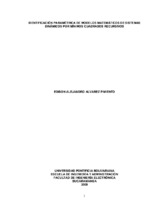Mostrar el registro sencillo del ítem
Identificación paramétrica de modelos de sistemas dinámicos por mínimos cuadrados recursivos
| dc.contributor.advisor | Barrios Urueña, Edgar | |
| dc.contributor.author | Alvarez Pimiento, Edison Alejandro | |
| dc.coverage.spatial | Seccional Bucaramanga. Universidad Pontificia Bolivariana. Escuela de Ingenierías. Facultad de Ingeniería Electrónica | spa |
| dc.coverage.temporal | 2009 | |
| dc.date.accessioned | 2013-07-16T21:54:02Z | |
| dc.date.available | 2013-07-16T21:54:02Z | |
| dc.date.created | 2010-02-24 | |
| dc.date.issued | 2013-07-16 | |
| dc.identifier.uri | http://hdl.handle.net/20.500.11912/666 | |
| dc.description | 63p.: (pdf); il; tablas; gráficas; anexos | spa |
| dc.description.abstract | Esta tesis dirigió su esfuerzo investigador, principalmente, a estudiar y aplicar el método de identificación recursivo con mínimos cuadrados para obtener el modelo matemático de un sistema lineal. El método se aplicó para obtener el modelo de la velocidad de un motor DC en función del voltaje aplicado. El método de identificación está basado en un algoritmo de mínimos cuadrados para la estimación de parámetros; el modelo resultante se expresa como función de Transferencia. Este método es muy apropiado para su uso en la identificación de sistemas dinámicos. Como parte complementaria del Proyecto se estudió Matlab y Labview; Matlab y Labview se usaron para realizar un programa que desarrolla el algoritmo de mínimos cuadrados recursivos. También se estudió el manejo del módulo de adquisición de datos USB 6009 de National Instruments y el manejo del osciloscopio digital Fluke para la adquisición de datos. La adquisición de datos se realizó con el módulo Ni 6009 y en osciloscopio Fluke; los datos adquiridos fueron los de voltaje de entrada al motor del módulo de servomecanismos Feedback y su velocidad. Los datos de entrada y salida del motor se llevaron al algoritmo de Mínimos cuadrados recursivos en Matlab y Labview y se obtuvo el modelo del motor, para cada caso, como función de transferencia. | spa |
| dc.description.abstract | This thesis focused its researching effort, mainly, to studying and applying the recursive identification method with least squares to obtain the math model of a lineal system. The method was applied to obtain the model of a DC motor’s speed depending on the applied voltage. The identification method is based on a least squares algorithm for the estimation of parameters; the outcome model it is expressed as a Transfer Function. This method is very appropriated for its use in the identification of dynamics systems. As complementary part of the project Matlab and LabVIEW were studied Matlab and LabVIEW were used to code a program that develops the algorithm of recursive least squares. The use of the Data Acquisition module (USB 6009) from National Instruments was also studied with the digital scope Fluke for data acquisition; the acquired data were motor voltage input (Feedback servo Fundamentals) and speed. The input and output data of the motor were taken to the Recursive Least Squares algorithm in Matlab and LabVIEW and the model of the motor was obtained, for each case, as Transfer Function. | spa |
| dc.language.iso | es | |
| dc.publisher | Universidad Pontificia Bolivariana | spa |
| dc.rights | Attribution-NonCommercial-NoDerivatives 4.0 International | * |
| dc.rights.uri | http://creativecommons.org/licenses/by-nc-nd/4.0/ | * |
| dc.subject | Ingeniería electrónica | spa |
| dc.subject | Tesis y disertaciones académicas | spa |
| dc.subject | Matlab - [programa para computador] | spa |
| dc.subject | Osciloscopios | spa |
| dc.subject | Labview [programa para computador] | spa |
| dc.title | Identificación paramétrica de modelos de sistemas dinámicos por mínimos cuadrados recursivos | spa |
| dc.type | bacherlorThesis | spa |
| dc.rights.accessRights | openAccess | spa |
| dc.type.hasVersion | publishedVersion | spa |
| dc.identifier.instname | instname:Universidad Pontificia Bolivariana | spa |
| dc.identifier.reponame | reponame:Repositorio Institucional de la Universidad Pontificia Bolivariana | spa |
| dc.identifier.repourl | repourl:https://repository.unab.edu.co/ |
Ficheros en el ítem
Este ítem aparece en la(s) siguiente(s) colección(ones)
-
Trabajos de grado [6440]
Monografías, artículos, informes, proyecto de grado


